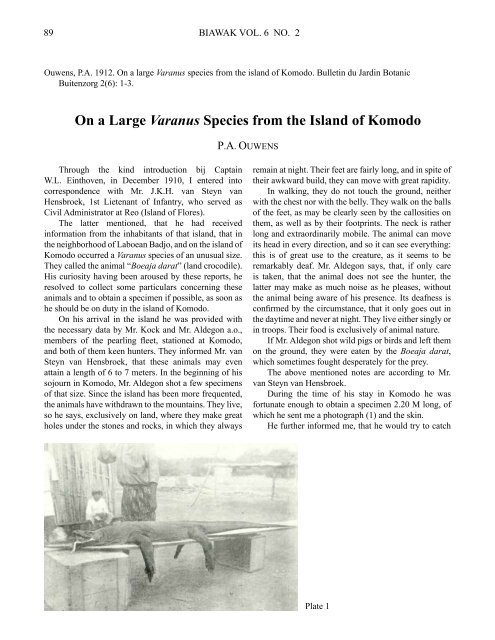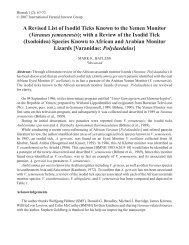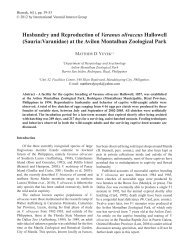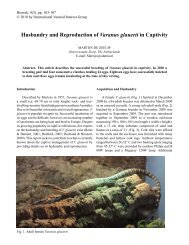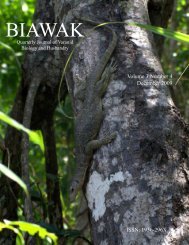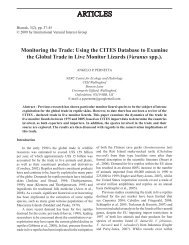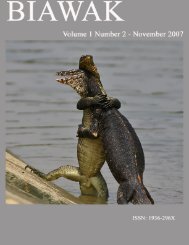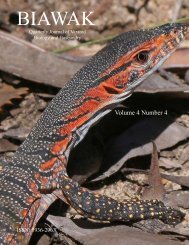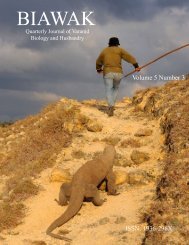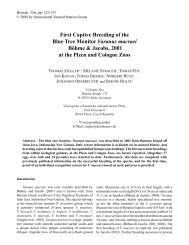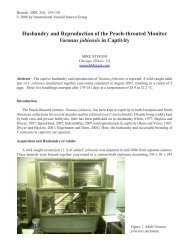Monitor - International Varanid Interest Group
Monitor - International Varanid Interest Group
Monitor - International Varanid Interest Group
- No tags were found...
You also want an ePaper? Increase the reach of your titles
YUMPU automatically turns print PDFs into web optimized ePapers that Google loves.
89 BIAWAK VOL. 6 NO. 2Ouwens, P.A. 1912. On a large Varanus species from the island of Komodo. Bulletin du Jardin BotanicBuitenzorg 2(6): 1-3.On a Large Varanus Species from the Island of KomodoP.A. OUWENSThrough the kind introduction bij CaptainW.L. Einthoven, in December 1910, I entered intocorrespondence with Mr. J.K.H. van Steyn vanHensbroek, 1st Lietenant of Infantry, who served asCivil Administrator at Reo (Island of Flores).The latter mentioned, that he had receivedinformation from the inhabitants of that island, that inthe neighborhood of Laboean Badjo, and on the island ofKomodo occurred a Varanus species of an unusual size.They called the animal “Boeaja darat” (land crocodile).His curiosity having been aroused by these reports, heresolved to collect some particulars concerning theseanimals and to obtain a specimen if possible, as soon ashe should be on duty in the island of Komodo.On his arrival in the island he was provided withthe necessary data by Mr. Kock and Mr. Aldegon a.o.,members of the pearling fleet, stationed at Komodo,and both of them keen hunters. They informed Mr. vanSteyn van Hensbroek, that these animals may evenattain a length of 6 to 7 meters. In the beginning of hissojourn in Komodo, Mr. Aldegon shot a few specimensof that size. Since the island has been more frequented,the animals have withdrawn to the mountains. They live,so he says, exclusively on land, where they make greatholes under the stones and rocks, in which they alwaysremain at night. Their feet are fairly long, and in spite oftheir awkward build, they can move with great rapidity.In walking, they do not touch the ground, neitherwith the chest nor with the belly. They walk on the ballsof the feet, as may be clearly seen by the callosities onthem, as well as by their footprints. The neck is ratherlong and extraordinarily mobile. The animal can moveits head in every direction, and so it can see everything:this is of great use to the creature, as it seems to beremarkably deaf. Mr. Aldegon says, that, if only careis taken, that the animal does not see the hunter, thelatter may make as much noise as he pleases, withoutthe animal being aware of his presence. Its deafness isconfirmed by the circumstance, that it only goes out inthe daytime and never at night. They live either singly orin troops. Their food is exclusively of animal nature.If Mr. Aldegon shot wild pigs or birds and left themon the ground, they were eaten by the Boeaja darat,which sometimes fought desperately for the prey.The above mentioned notes are according to Mr.van Steyn van Hensbroek.During the time of his stay in Komodo he wasfortunate enough to obtain a specimen 2.20 M long, ofwhich he sent me a photograph (1) and the skin.He further informed me, that he would try to catchPlate 1


